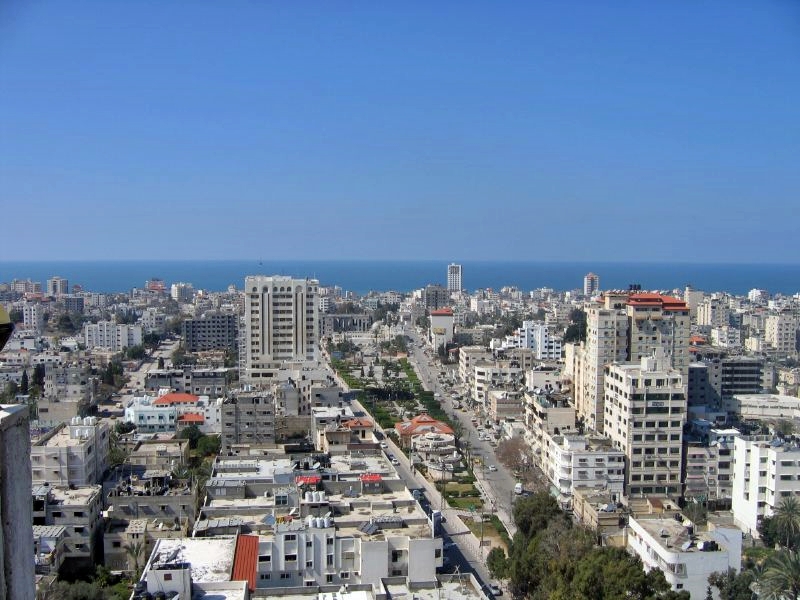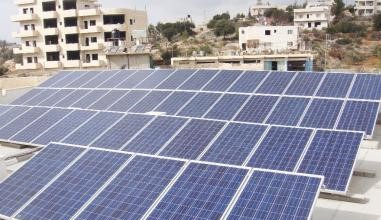With a unique set of critical energy challenges, Palestine is an ideal environment for off-grid renewable energy and boasts many initiatives and projects, large and small, which are either in the planning stages or operational. This is the second in a two-part series (read Part 1 here).

Gaza City: the Gaza Strip’s high and growing population density and lack of access to electricity create an enormous energy crisis some hope to resolve via renewable microgrid projects.
Dire situation in besieged Gaza Strip
Gaza’s acute power shortage has been ongoing since the strip’s main power station was bombed 10 years ago. The area’s 1.9 million residents require approximately 400 MW of electricity but only about half that amount is available. Current energy sources include “10 power lines from Israel with 120 megawatts (MW), two power lines from Egypt with 25 MW, and Gaza’s local power plant (GPP) that generates 60 MW,” according to Al-Monitor. This crisis is so dire that many hospitals and schools are in desperate need of electricity. Residents most often have access to less than eight hours of electricity per day. The Monitor reports that Palestinian Energy & Natural Resources Authority (PENRA)’s director of information in Gaza, Ahmed Abu al-Amrein, said PENRA has begun a program of encouraging citizens to rely on solar energy, as Gaza averages 300 days of sunshine a year.
UN, OFID bring Gaza schools out of the dark
The United Nations Development Program (UNDP)’s “Renewable Energy Generation through Solar Panels for Public Education, Health and Water Facilities” supports the Palestinian Solar Initiative through a half-million-dollar project funded by the The OPEC Fund for International Development (OFID). According to a story last year in PV-Magazine, UNDP estimates that installing solar for schools and hospitals would benefit more than 100,000 Gazans.
“The electricity shortage hindered the educational process, especially in winter,” Maha El Tawil, headmistress at the Bashir El Rayyes High School, says in the 2015 story. Due to Gaza’s severe school shortage, her 1,800 students attend school in two shifts. “This was a challenge for teachers and students operating the second shift. We used to teach in the dark — unable to read what was written on the board nor in the books,” she says. “We needed a better alternative.”
Installed solar systems have brought light to the classrooms and enabled reinstatement of regularly scheduled computer classes. The completed project is estimated to benefit more than 100,000 people. The Palestinian government, international organizations, and private investors are all involved in other Gaza projects, from those helping several hundred people to one designed to bring the area 200 MW of solar power. With the area’s dire electricity and water shortages, their success may literally mean the difference between life and death.
In the West Bank, challenging obstacles but easier access for international assistance
Palestine’s Energy Authority moved forward last summer on development of the West Bank’s first solar park, to be built near Hebron. The project, a $10 million, 5.7 MW plant , has been awarded to Dutch firm Gigawatt Global Cooperatief UA and Palestinian firm Rack Tec and is being financed by American company Overseas Private Investment Corp. The Energy Authority is planning 10 additional solar parks (up to 10 MW each). Two are scheduled for bidding in 2017 and all are slated to be completed within the next five years. The solar parks are estimated to save Palestinians up to $100 million.
A national renewable energy strategy

Commercial PV system in Beit Fajjar municipality (central West Bank). Photos of this and other Sunergy projects can be found here.
With the Palestinian government’s recent recognition that renewable energy must be the way forward in Palestine for both industry and public use and expanded its national strategy has recognized the importance of exhausting the opportunities in renewable energy for the adequate supply of clean energy for residential, commercial and industrial needs. The Palestinian government has recognized the importance of exhausting the opportunities in renewable energy for the adequate supply of clean energy for residential, commercial and industrial needs. The government recently announced a national strategy for expanding the use of renewable energy calling for the production of 120 MW of electricity using a variety of AE energy sources.
New companies are sprouting up throughout Palestine to deliver the national strategy through investment in renewable energy. Sunergy, a local Palestinian company that designs RE solutions and supplies hardware, technology, installation, and support services, is committed to educating Palestinians about “changing mindsets and promoting the use of Palestine’s natural resources” and hopes to help grow the Palestinian alternative energy market toward energy independence. The company has installed an impressive number of both residential and commercial systems in Jericho, Hebron, Beit Fajjar and other locations. It’s helping bring much-needed power to Palestinian hospitals and schools — as it looks forward toward Palestine’s green energy future.
